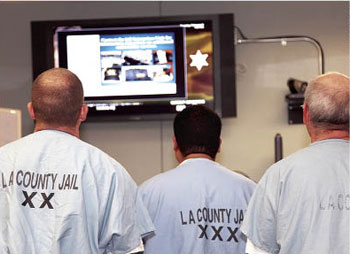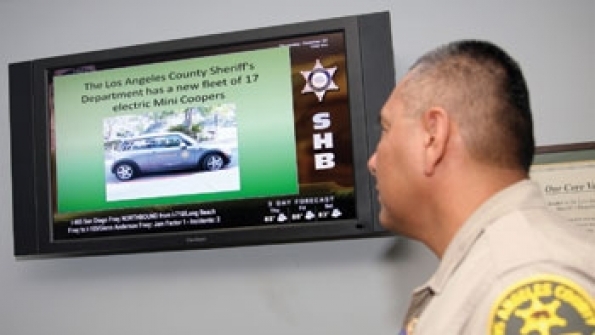Clipboards are a thing of the past (with related video)
A revolution is occurring in law enforcement today, and it’s taking place on smartphone and tablet-computer screens. But there’s another type of revolution, one that is scarcely talked about but is just as transformative. It is taking place on larger screens that incorporate everything that we’ve come to value in smartphones and tablets but hang on the wall instead. It helps the personnel in our stations and our jails to better communicate, increase efficiency and learn. It’s digital signage.
With nearly 18,000 full-time personnel — including roughly 10,000 sworn deputies and 8,000 civilians — plus 5,000 volunteers, the Los Angeles County Sheriff’s Department operates the second-largest law-enforcement agency in the nation. The department polices 42 cities and 130 communities, including myriad transit lines and colleges, and operates the largest jail and court systems in the nation. Consequently, the department has a wide range of units and assignments. Reaching this diverse team at more than 100 locations over 4,000 square miles is a logistical challenge, especially in terms of ensuring unified messages.
In the past, law-enforcement leaders would write policies and distribute them — but the world has changed and our employees have changed with it. There’s a new generation and a new expectation: If it’s not on a TV or computer screen, it’s just not as real. If officials think they can just create a policy, and then hand it out or read it at a briefing and presume it’s going to be absorbed, they are mistaken. Clearly, we are competing against society’s new dynamic and visual methods of communication for our employees’ attention. But, as L.A. County Sheriff Lee Baca said, “We don’t want to compete — we’d rather adopt it and adapt to it.”
That’s what the department did when it implemented a digital signage system developed by Hughes Network Systems. Baca recognized that the system — also known as digital briefing boards — presented an opportunity to bridge the communications gap and to unify the department’s message. On the surface the boards look like the large, wall-mounted, flat-screen TVs that one would find in any electronics store, but instead of a cable or satellite feed they are plugged into the department’s internal data network. As such, they are more analogous to the types of displays one would find in a flight simulator, only optimized for the office.
Walk into one of our briefing rooms and you will one of these displays on the wall playing a series of officer-safety videos. You also will see it piping training information to employees. And, if you have the misfortune of being incarcerated, you’ll see it displaying real-time updates on your booking progress in the county jails, information that keep our deputies on track and ensures that you’re in one door and out the other within the legally-mandated time period.
Digital signage is an advanced way for the department to communicate with its personnel, to feature their good work, to educate and to share new information It is a 21st-century tool that helps them get their jobs done faster and more effectively. Today the department has more than 100 digital signage screens, and is looking to add more. But it’s not about the number of screens — it’s about how they are used.
One of its first implementations was simply to spread the word about how the department’s work is being perceived by the public. Keeping the peace and providing service to the community is our mission, so understanding how we’re being portrayed in the news — whether good or not so good — can help our personnel stay alert and keep them aware of events that directly affect them. To that end the department subscribes to a TV news monitoring service, so we now receive a visual of any story that depicts the department. This remains one of the system’s most popular features, but it’s not the only one.
For instance, this visually engaging system had made a big difference in terms of keeping personnel up to speed on the department’s efforts in the community. Multimedia presentations are created for a wide variety of initiatives — from routine assignments to special events and major deployments — that are displayed on the digital signage screens. It’s not as difficult as one might think: Take a few quotes from a standard briefing memo, add a photo and insert them into PowerPoint. We even use relevant video from YouTube. The difference in engagement is dramatic, and when you get people’s attention, learning ensues.
The system also has proved quite useful as a tool to rapidly disseminate official department statements. In today’s social-media environment, the words or actions of any one of our thousands of employees could be picked up by bloggers and potentially could go viral — so ensuring that our people have a first-hand understanding of the department’s perspective is crucial. We still send out e-mails, but putting the same messages on a screen that is right in front of personnel has a far more immediate and memorable impact and motivates them to read the e-mail more closely. This is especially true for younger generations of employees who are lifetime members of the digital age.
Digital signage also helps to the department to showcase positive stories, such as our recent Medal of Valor ceremony. This is a major event, but it’s one that only a fraction of our personnel is able to attend. So, in addition to the usual news-release posting via our website, Nixle instant messaging and social media, we live-streamed the ceremony over the Internet, and over our digital briefing boards for those who were on-duty at the time.
Soon, we’ll be live-streaming our press conferences over the digital signage system. Instead of our employees seeing only the few seconds that the news media chooses to air, thousands of them will be able to see the complete event as it happens. While some might argue that live-streaming over the Internet would be sufficient for this purpose, the department believes that Internet streaming alone would have several drawbacks. One is that it requires one to be sitting in front of a computer. More vexing is that should a large number of employees live-stream the event simultaneously, it would place enormous and expensive strains on the department’s internal data-networks. Digital signage helps fill the gap.
Digital signage has been taken to new levels in the county’s jails. When individuals are incarcerated, the first step is booking, which involves entering them into the jail system, gauging their physical and mental health, and making a determination as to the risk they pose to other inmates, and vice versa. These intake areas have different regulatory standards than other incarceration facilities because they do not have long-term living amenities such as beds. Legal restrictions limit the period from the time of intake to the time of output to 24 hours, and keeping to that time frame is a top priority. Digital signage helps the department achieve this goal.
In the county jail’s inmate reception center — the largest inmate intake center in the U.S. — the sheriff’s department processes between 300 and 500 new bookings every day, in addition to court transports and inmate releases. Digital signage that displays inmate progress via a series of colored bars similar to that of a TV’s volume indicator — green, light green, yellow, orange and red — always is visible in the center. The moment a new inmate enters the jail and into the booking process, his wristband is barcode-scanned and logged into the digital signage system. The aforementioned bar graph depicts the number of inmates that are being processed by the hour: 0 to 5 hours (green), 6 to 10 hours (light green), 11 to 15 hours (yellow), 16 to 20 hours (orange) and 21 to 24 hours (red bar). We consider it a major priority (yellow) even before an individual has been in the system for half a day.

To keep everyone’s attention on high, the moment an inmate enters the light-green level, everyone on duty knows it and the tension builds. The advantage of the digital signage system is that it can be used to broadcast this information to the entire team, something that can’t be done when the data is housed solely on clipboards. Human nature has taught us that if you can’t avoid the message, you will act on it.
Digital signage also has made it easier to supervise line personnel; in fact it makes it possible for personnel to help supervise each other. Most important, it has made it impossible for bookings to quietly and unintentionally fall through the cracks — and that’s a big deal. With multiple shifts and so many inmates, there are a lot of moving parts. Capt. Chuck Antuna, who is the inmate reception center’s unit commander, credits the digital signage — along with new barcode scanners and other process improvements — with creating an environment that reduces processing time and tension among inmates. Since the signage was introduced in 2010, the department has not exceeded the mandated processing time even once.
“Bottom line, this technology has allowed us to be more efficient and do better with less,” Antuna said.
Already we’ve used the digital signage system to deliver information and educational content — but we’ve only scratched the surface when it comes to employee training. Training and education is the lifeblood of our department, but for an organization of our size it presents unique challenges. Because we’re the sole policing presence for nearly 4 million people, something as simple as getting across the county for an afternoon training session could take several hours in each direction for some of our personnel, due to the region’s notorious traffic tie-ups. That not only wastes valuable time and energy, it also makes training a costly chore. With digital signage, we could teach a class throughout the entire department; one instructor on one end and potentially 1,000 employees at various stations on the other.
Law enforcement, like other organizations, is required to do more with less these days, and the right technology, when used well, is an enabler. Our digital signage system is an example of the right technology. But already, Hughes is working to take it one step further. “Today’s screens are passive, one-way communication,” said Tony Bardo, the company’s assistant vice president of government solutions. “But if you change that to a touchscreen so the user can interact with the information, the possibilities for training and distance learning are endless.”
Interactive screens have additional potential, including roll-call briefings that stand to improve efficiencies across our organization. But like any other tool, digital signage is only as good as the time and ingenuity that one puts into it.
When we share our story with smaller policing agencies, they wonder whether digital signage would be worthwhile for them — not every jurisdiction is plagued by hours of traffic jams like L.A. County. They also wonder whether they will have enough content to display on the signage 24/7. But there’s plenty of content out there if you look: Go to YouTube and search for public-safety videos; go to iTunes U and seek out training videos; and engage your colleagues to discover what’s worked and what hasn’t. Share the content you find with other agencies.
Could the L.A. County Sheriff’s Department get by without digital signage? Yes. It has in the past. But could we be as effective, engaged and alert to our environment as we are today? Digital signage at its heart is about movement — moving images and colorful graphics. There is no better word to describe the environment in which we work than movement. For us, digital signage has helped to ensure that we’re always moving in the right direction.
Mike Parker is a captain with the L.A. County Sheriff’s Department and the unit commander of its headquarters bureau, which is responsible for internal and external communications, as well as media relations.
Related Video

















